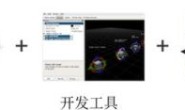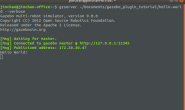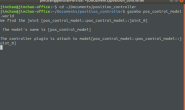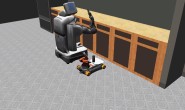新建环境模型
- 1 控制器结构
- 2 操作函数
- 2.1 初始化函数
- 2.2 距离传感器操作函数
- 2.3 ground_sensors 操作函数
- 2.4 激光雷达传感器操作函数
- 2.5 LED灯作函数
- 2.7 电机操作函数
- 3 DEMO
- 参考资料
这里我们分析webots中的基础控制器,这是由于这其中涉及到很多的基础控制函数(比如读取传感器数据、控制电机),通过了解这些基础控制器中的操作函数,为我们后面介绍ROS控制做基础。这里以webots自带的机器人 e-puck 的控制器为例,介绍webots控制器的编写规范。 首先我们打开 e-puck_line.wbt 模型文件,选择自带的避障控制器,如下图:

1 控制器结构
webots的控制器和C语言的语法非常相似,入口地址为函数main()函数,webots访问机器人上的每一个传感器(距离传感器)和执行器(电机)都是依靠操作句柄实现的,操作句柄可以被理解为一个结构体,每一个传感器都对应一个操作句柄,在创建这个操作句柄的时候需要输入这个传感器的名称。
/* include headers */
#include <stdio.h>
#include <stdlib.h>
#include <string.h>
#include <webots/device.h>
#include <webots/distance_sensor.h>
#include <webots/led.h>
#include <webots/motor.h>
#include <webots/nodes.h>
#include <webots/robot.h>
/* Device stuff */
#define DISTANCE_SENSORS_NUMBER 8
static WbDeviceTag distance_sensors[DISTANCE_SENSORS_NUMBER];
static double distance_sensors_values[DISTANCE_SENSORS_NUMBER];
static const char *distance_sensors_names[DISTANCE_SENSORS_NUMBER] = {"ps0", "ps1", "ps2", "ps3", "ps4", "ps5", "ps6", "ps7"};
#define GROUND_SENSORS_NUMBER 3
static WbDeviceTag ground_sensors[GROUND_SENSORS_NUMBER];
static double ground_sensors_values[GROUND_SENSORS_NUMBER] = {0.0, 0.0, 0.0};
static const char *ground_sensors_names[GROUND_SENSORS_NUMBER] = {"gs0", "gs1", "gs2"};
#define LEDS_NUMBER 10
static WbDeviceTag leds[LEDS_NUMBER];
static bool leds_values[LEDS_NUMBER];
static const char *leds_names[LEDS_NUMBER] = {"led0", "led1", "led2", "led3", "led4", "led5", "led6", "led7", "led8", "led9"};
static WbDeviceTag left_motor, right_motor;
#define LEFT 0
#define RIGHT 1
#define MAX_SPEED 6.28
static double speeds[2];
/* Breitenberg stuff */
static double weights[DISTANCE_SENSORS_NUMBER][2] = {{-1.3, -1.0}, {-1.3, -1.0}, {-0.5, 0.5}, {0.0, 0.0},
{0.0, 0.0}, {0.05, -0.5}, {-0.75, 0}, {-0.75, 0}};
static double offsets[2] = {0.5 * MAX_SPEED, 0.5 * MAX_SPEED};
static int get_time_step() {
static int time_step = -1;
if (time_step == -1)
time_step = (int)wb_robot_get_basic_time_step();
return time_step;
}
static void step() {
if (wb_robot_step(get_time_step()) == -1) {
wb_robot_cleanup();
exit(EXIT_SUCCESS);
}
}
static void passive_wait(double sec) {
double start_time = wb_robot_get_time();
do {
step();
} while (start_time + sec > wb_robot_get_time());
}
static void init_devices() {
int i;
for (i = 0; i < DISTANCE_SENSORS_NUMBER; i++) {
distance_sensors[i] = wb_robot_get_device(distance_sensors_names[i]);
wb_distance_sensor_enable(distance_sensors[i], get_time_step());
}
for (i = 0; i < LEDS_NUMBER; i++)
leds[i] = wb_robot_get_device(leds_names[i]);
// silently initialize the ground sensors if they exists
for (i = 0; i < GROUND_SENSORS_NUMBER; i++)
ground_sensors[i] = (WbDeviceTag)0;
int ndevices = wb_robot_get_number_of_devices();
for (i = 0; i < ndevices; i++) {
WbDeviceTag dtag = wb_robot_get_device_by_index(i);
const char *dname = wb_device_get_name(dtag);
WbNodeType dtype = wb_device_get_node_type(dtag);
if (dtype == WB_NODE_DISTANCE_SENSOR && strlen(dname) == 3 && dname[0] == 'g' && dname[1] == 's') {
int id = dname[2] - '0';
if (id >= 0 && id < GROUND_SENSORS_NUMBER) {
ground_sensors[id] = wb_robot_get_device(ground_sensors_names[id]);
wb_distance_sensor_enable(ground_sensors[id], get_time_step());
}
}
}
// get a handler to the motors and set target position to infinity (speed control).
left_motor = wb_robot_get_device("left wheel motor");
right_motor = wb_robot_get_device("right wheel motor");
wb_motor_set_position(left_motor, INFINITY);
wb_motor_set_position(right_motor, INFINITY);
wb_motor_set_velocity(left_motor, 0.0);
wb_motor_set_velocity(right_motor, 0.0);
step();
}
static void reset_actuator_values() {
int i;
for (i = 0; i < 2; i++)
speeds[i] = 0.0;
for (i = 0; i < LEDS_NUMBER; i++)
leds_values[i] = false;
}
static void get_sensor_input() {
int i;
for (i = 0; i < DISTANCE_SENSORS_NUMBER; i++) {
distance_sensors_values[i] = wb_distance_sensor_get_value(distance_sensors[i]);
// scale the data in order to have a value between 0.0 and 1.0
// 1.0 representing something to avoid, 0.0 representing nothing to avoid
distance_sensors_values[i] /= 4096;
}
for (i = 0; i < GROUND_SENSORS_NUMBER; i++) {
if (ground_sensors[i])
ground_sensors_values[i] = wb_distance_sensor_get_value(ground_sensors[i]);
}
}
static bool cliff_detected() {
int i;
for (i = 0; i < GROUND_SENSORS_NUMBER; i++) {
if (!ground_sensors[i])
return false;
if (ground_sensors_values[i] < 500.0)
return true;
}
return false;
}
static void set_actuators() {
int i;
for (i = 0; i < LEDS_NUMBER; i++)
wb_led_set(leds[i], leds_values[i]);
wb_motor_set_velocity(left_motor, speeds[LEFT]);
wb_motor_set_velocity(right_motor, speeds[RIGHT]);
}
static void blink_leds() {
static int counter = 0;
counter++;
leds_values[(counter / 10) % LEDS_NUMBER] = true;
}
static void run_braitenberg() {
int i, j;
for (i = 0; i < 2; i++) {
speeds[i] = 0.0;
for (j = 0; j < DISTANCE_SENSORS_NUMBER; j++)
speeds[i] += distance_sensors_values[j] * weights[j][i];
speeds[i] = offsets[i] + speeds[i] * MAX_SPEED;
if (speeds[i] > MAX_SPEED)
speeds[i] = MAX_SPEED;
else if (speeds[i] < -MAX_SPEED)
speeds[i] = -MAX_SPEED;
}
}
static void go_backwards() {
wb_motor_set_velocity(left_motor, -MAX_SPEED);
wb_motor_set_velocity(right_motor, -MAX_SPEED);
passive_wait(0.2);
}
static void turn_left() {
wb_motor_set_velocity(left_motor, -MAX_SPEED);
wb_motor_set_velocity(right_motor, MAX_SPEED);
passive_wait(0.2);
}
int main(int argc, char **argv) {
wb_robot_init();
printf("Default controller of the e-puck robot started...\n");
init_devices();
while (true) {
reset_actuator_values();
get_sensor_input();
blink_leds();
if (cliff_detected())
{
go_backwards();
turn_left();
}
else
{
run_braitenberg();
}
set_actuators();
step();
};
return EXIT_SUCCESS;
}
2 操作函数
首先我们来看看上面文件中的主要操作函数
2.1 初始化函数
webots的初始化函数为
1 wb_robot_init();
2.2 距离传感器操作函数
 1、e-puck有着8个距离传感器名字分别为(“ps0”, “ps1”, “ps2”, “ps3”, “ps4”, “ps5”, “ps6”, “ps7”)
1、e-puck有着8个距离传感器名字分别为(“ps0”, “ps1”, “ps2”, “ps3”, “ps4”, “ps5”, “ps6”, “ps7”)
1 #define DISTANCE_SENSORS_NUMBER 8
2 static WbDeviceTag distance_sensors[DISTANCE_SENSORS_NUMBER]; // 申明数组
3 static double distance_sensors_values[DISTANCE_SENSORS_NUMBER];
4 static const char *distance_sensors_names[DISTANCE_SENSORS_NUMBER] = {"ps0", "ps1", "ps2", "ps3", "ps4", "ps5", "ps6", "ps7"};
2、构建操作句柄,使能传感器
1 int i;
2 for (i = 0; i < DISTANCE_SENSORS_NUMBER; i++) {
3 distance_sensors[i] = wb_robot_get_device(distance_sensors_names[i]);
4 wb_distance_sensor_enable(distance_sensors[i], get_time_step());
5 }
3、读取传感器的数据
int i;
for (i = 0; i < DISTANCE_SENSORS_NUMBER; i++) {
distance_sensors_values[i] = wb_distance_sensor_get_value(distance_sensors[i]);
// scale the data in order to have a value between 0.0 and 1.0
// 1.0 representing something to avoid, 0.0 representing nothing to avoid
distance_sensors_values[i] /= 4096;
}
2.3 ground_sensors 操作函数
1、初始化变量
#define GROUND_SENSORS_NUMBER 3
static WbDeviceTag ground_sensors[GROUND_SENSORS_NUMBER];
static double ground_sensors_values[GROUND_SENSORS_NUMBER] = {0.0, 0.0, 0.0};
static const char *ground_sensors_names[GROUND_SENSORS_NUMBER] = {"gs0", "gs1", "gs2"};
2、构建操作句柄,使能传感器
ground_sensors[id] = wb_robot_get_device(ground_sensors_names[id]);
wb_distance_sensor_enable(ground_sensors[id], get_time_step());
3、读取传感器的数据
for (i = 0; i < GROUND_SENSORS_NUMBER; i++) {
if (ground_sensors[i])
ground_sensors_values[i] = wb_distance_sensor_get_value(ground_sensors[i]);
}
2.4 激光雷达传感器操作函数
2.5 LED灯作函数
1、声明变量
#define LEDS_NUMBER 10
static WbDeviceTag leds[LEDS_NUMBER];
static bool leds_values[LEDS_NUMBER];
static const char *leds_names[LEDS_NUMBER] = {"led0", "led1", "led2", "led3", "led4", "led5", "led6", "led7", "led8", "led9"};
2、构建操作句柄
for (i = 0; i < LEDS_NUMBER; i++)
leds[i] = wb_robot_get_device(leds_names[i]);
3、设置LED的值
for (i = 0; i < LEDS_NUMBER; i++)
wb_led_set(leds[i], leds_values[i]);
2.7 电机操作函数
1、获取电机操作句柄。”left wheel motor”表示电机的名称
left_motor = wb_robot_get_device("left wheel motor");
right_motor = wb_robot_get_device("right wheel motor");
2、设置电机行进的位移
wb_motor_set_position(left_motor, INFINITY);
wb_motor_set_position(right_motor, INFINITY);
3、设置电机速度
wb_motor_set_velocity(left_motor, 0.0);
wb_motor_set_velocity(right_motor, 0.0);
从上面的形式来看,每一个传感器操作都会经历声明变量、构建操作句柄、获取传感器值三个操作,其中获取操作句柄都是使用的 wb_robot_get_device() 这个函数实现的。
3 DEMO
下面是我在【2】上修改到的一个控制,读取距离传感器的值实现小车避障,同时小车身上的灯会循环点亮。
 以下是c文件的控制器代码
以下是c文件的控制器代码
#include <webots/robot.h>
#include <webots/distance_sensor.h>
#include <webots/motor.h>
#include <webots/led.h>
// time in [ms] of a simulation step
#define TIME_STEP 64
#define MAX_SPEED 6.28
/* Device stuff */
#define DISTANCE_SENSORS_NUMBER 8
static WbDeviceTag distance_sensors[DISTANCE_SENSORS_NUMBER];
static double distance_sensors_values[DISTANCE_SENSORS_NUMBER];
static const char *distance_sensors_names[DISTANCE_SENSORS_NUMBER] = {"ps0", "ps1", "ps2", "ps3", "ps4", "ps5", "ps6", "ps7"};
#define LEDS_NUMBER 10
static WbDeviceTag leds[LEDS_NUMBER];
static bool leds_values[LEDS_NUMBER];
static const char *leds_names[LEDS_NUMBER] = {"led0", "led1", "led2", "led3", "led4", "led5", "led6", "led7", "led8", "led9"};
static int counter = 0;
// entry point of the controller
int main(int argc, char **argv) {
// initialize the Webots API
wb_robot_init();
// internal variables
int i;
for (i = 0; i < DISTANCE_SENSORS_NUMBER; i++) {
distance_sensors[i] = wb_robot_get_device(distance_sensors_names[i]);
wb_distance_sensor_enable(distance_sensors[i], TIME_STEP);
}
for (i = 0; i < LEDS_NUMBER; i++)
leds[i] = wb_robot_get_device(leds_names[i]);
WbDeviceTag left_motor = wb_robot_get_device("left wheel motor");
WbDeviceTag right_motor = wb_robot_get_device("right wheel motor");
wb_motor_set_position(left_motor, INFINITY);
wb_motor_set_position(right_motor, INFINITY);
wb_motor_set_velocity(left_motor, 0.0);
wb_motor_set_velocity(right_motor, 0.0);
// feedback loop: step simulation until an exit event is received
while (wb_robot_step(TIME_STEP) != -1) {
// read sensors outputs
for (i = 0; i < DISTANCE_SENSORS_NUMBER ; i++)
distance_sensors_values[i] = wb_distance_sensor_get_value(distance_sensors[i]);
// detect obstacles
bool right_obstacle =
distance_sensors_values[0] > 80.0 ||
distance_sensors_values[1] > 80.0 ||
distance_sensors_values[2] > 80.0;
bool left_obstacle =
distance_sensors_values[5] > 80.0 ||
distance_sensors_values[6] > 80.0 ||
distance_sensors_values[7] > 80.0;
// initialize motor speeds at 50% of MAX_SPEED.
double left_speed = 0.5 * MAX_SPEED;
double right_speed = 0.5 * MAX_SPEED;
// modify speeds according to obstacles
if (left_obstacle) {
// turn right
left_speed += 0.5 * MAX_SPEED;
right_speed -= 0.5 * MAX_SPEED;
}
else if (right_obstacle) {
// turn left
left_speed -= 0.5 * MAX_SPEED;
right_speed += 0.5 * MAX_SPEED;
}
for (i = 0; i < LEDS_NUMBER; i++)
leds_values[i] = false;
counter++;
leds_values[(counter / 10) % LEDS_NUMBER] = true;
for (i = 0; i < LEDS_NUMBER; i++)
wb_led_set(leds[i], leds_values[i]);
// write actuators inputs
wb_motor_set_velocity(left_motor, left_speed);
wb_motor_set_velocity(right_motor, right_speed);
}
// cleanup the Webots API
wb_robot_cleanup();
return 0; //EXIT_SUCCESS
}
参考资料
[1] https://www.cyberbotics.com/doc/reference/motion [2] https://cyberbotics.com/doc/guide/tutorial-4-more-about-controllers?tab-language=c 如果大家觉得文章对你有所帮助,麻烦大家帮忙点个赞。O(∩_∩)O




